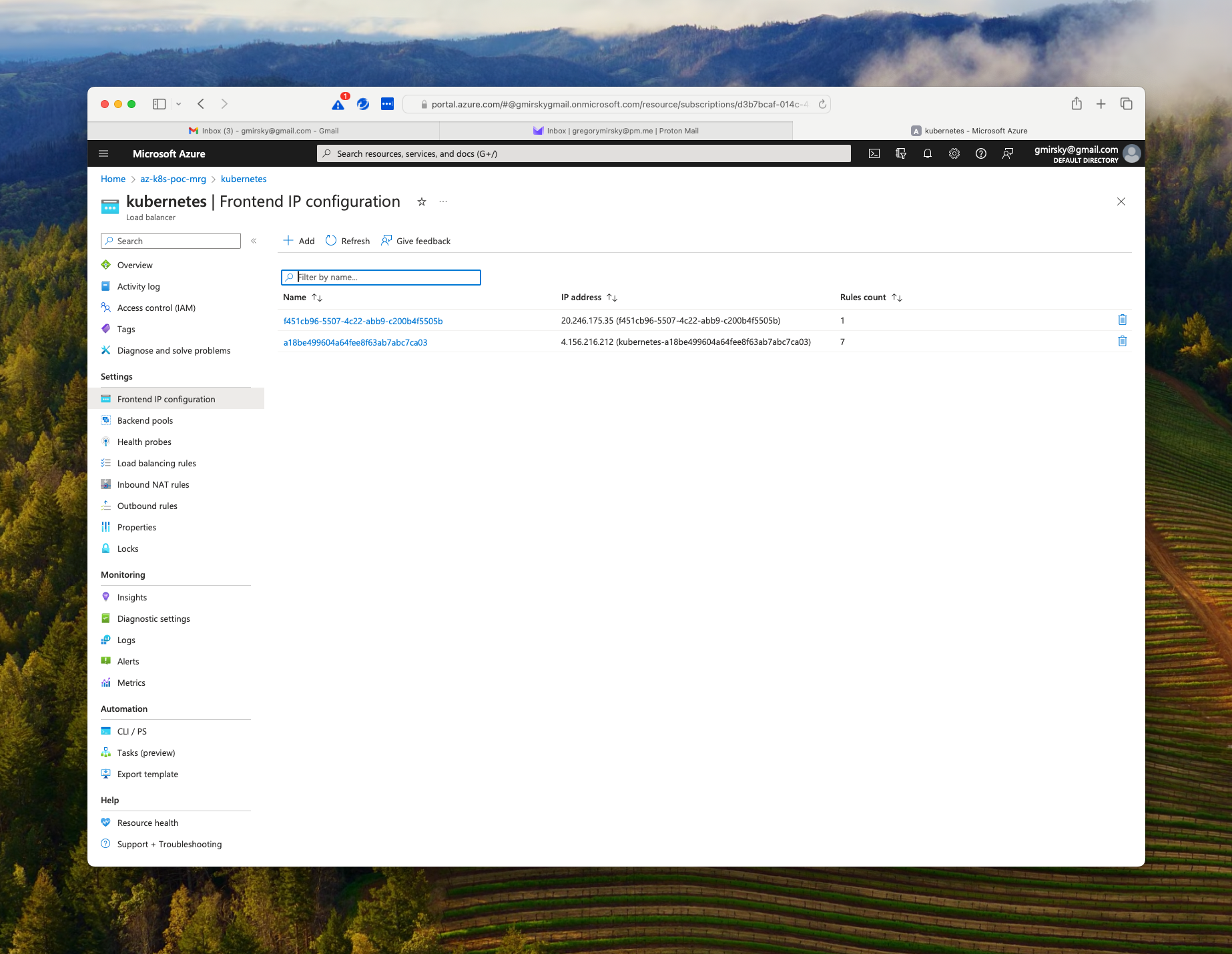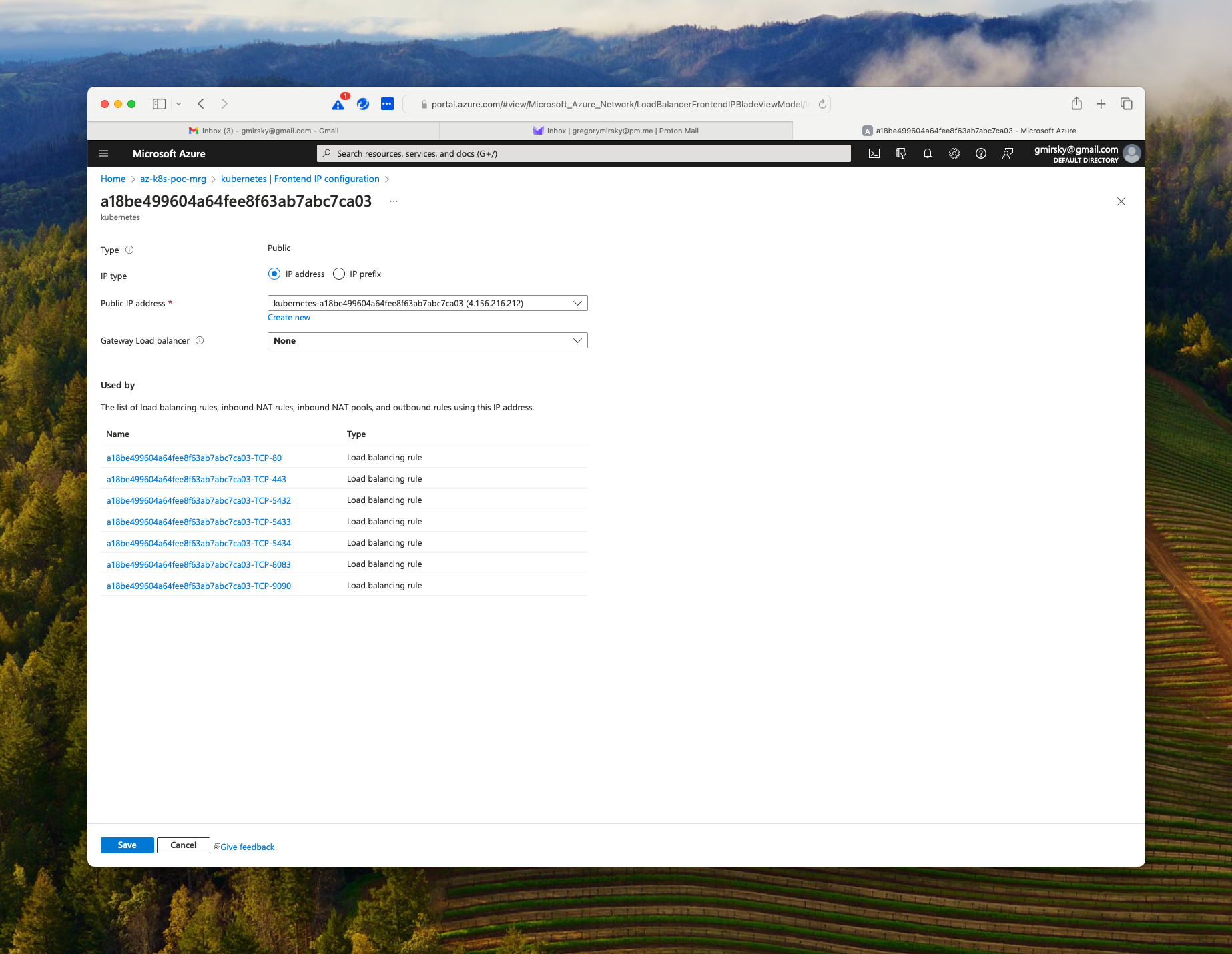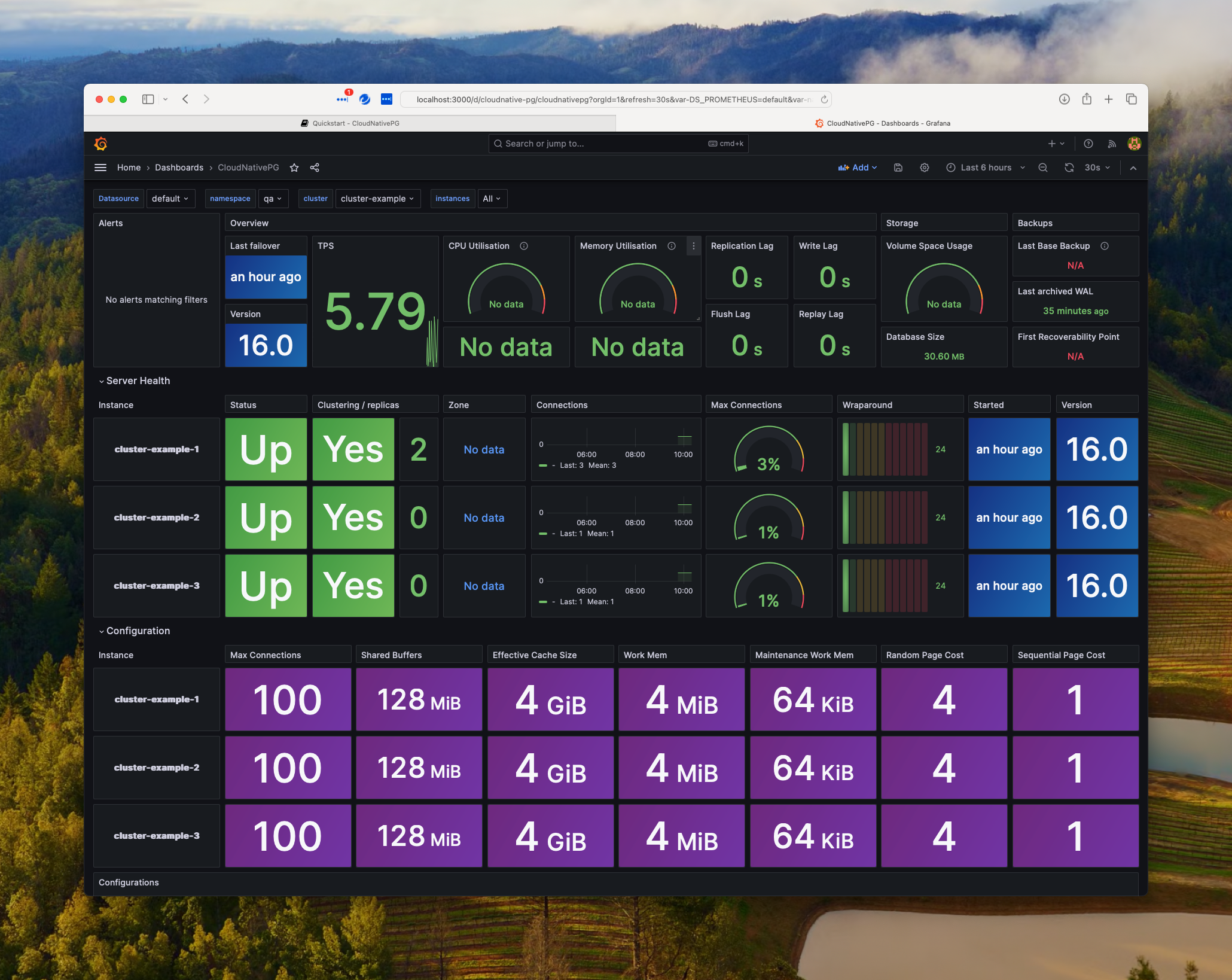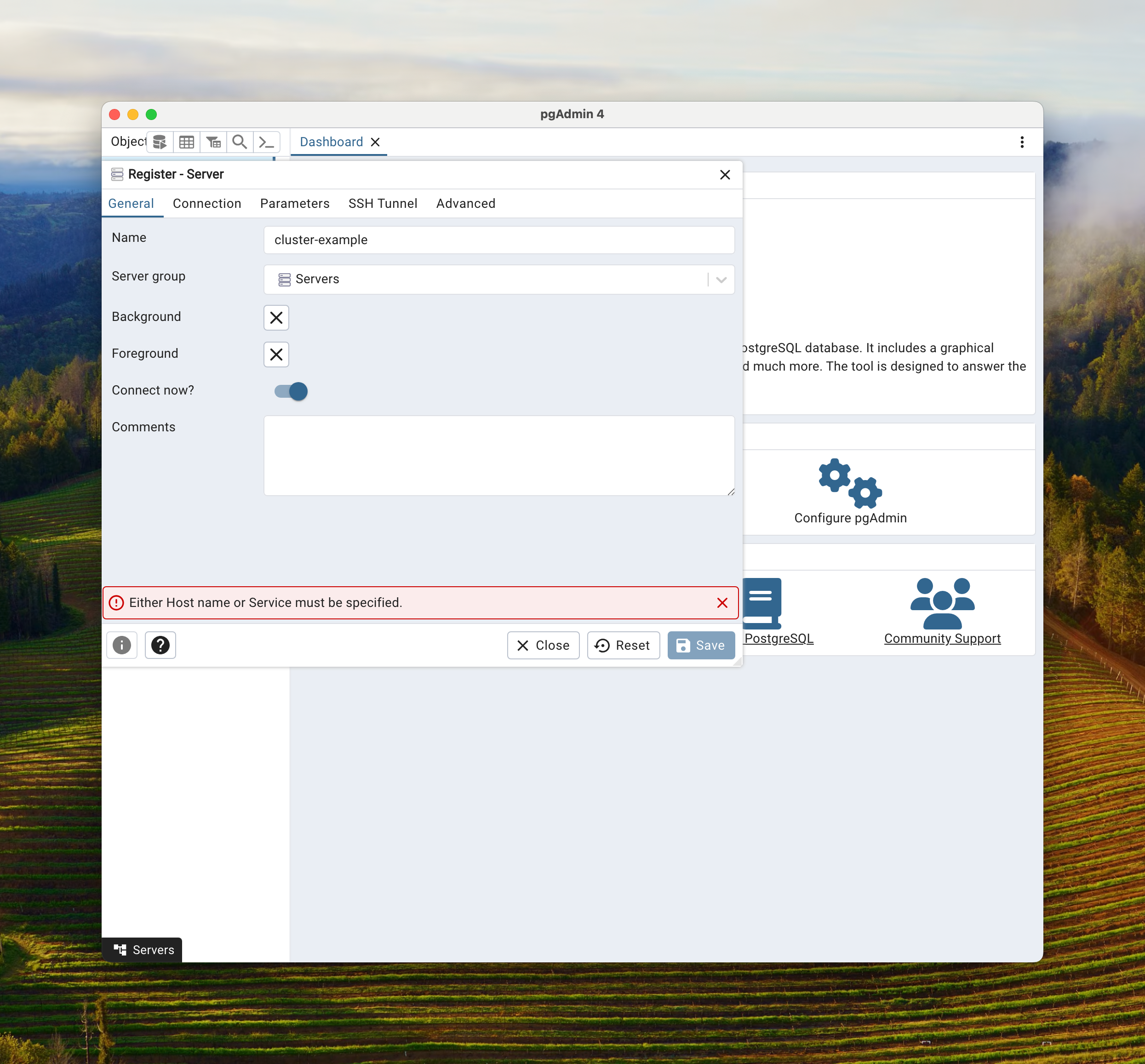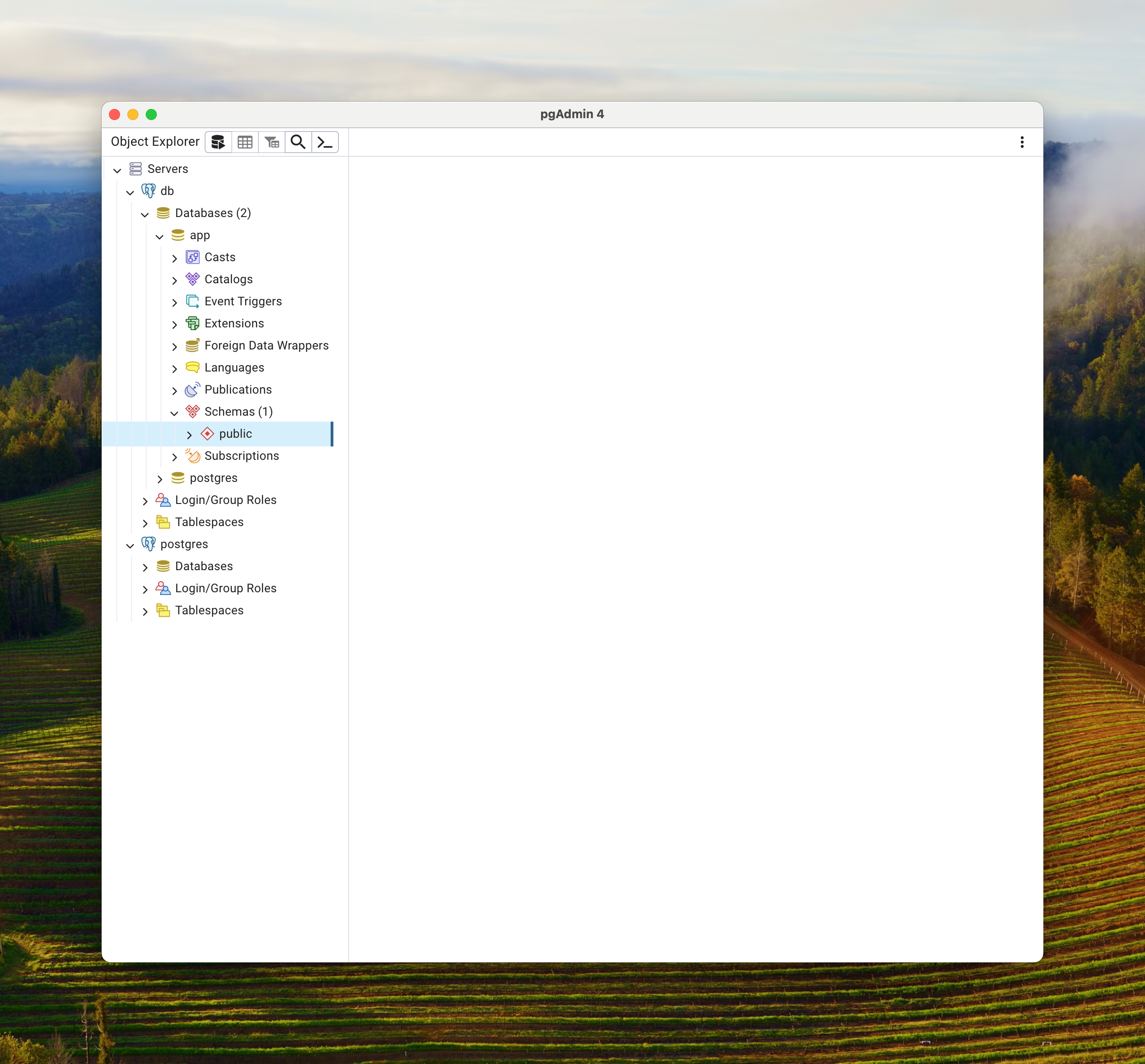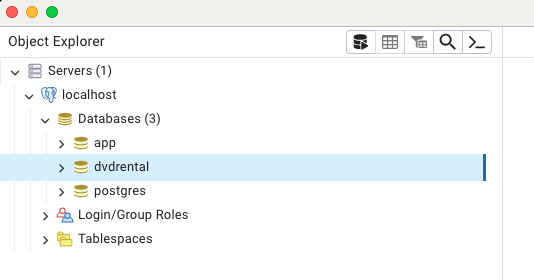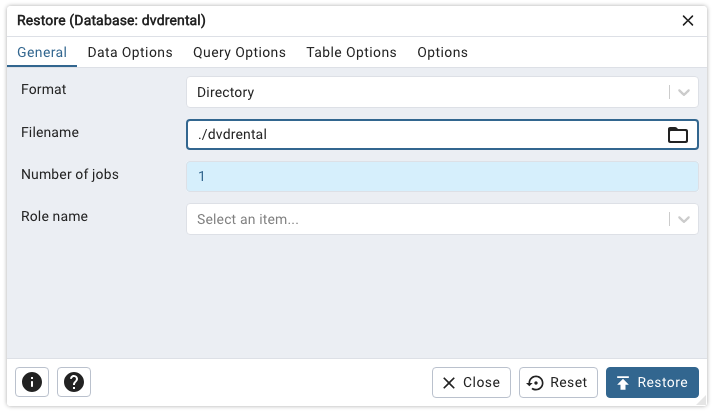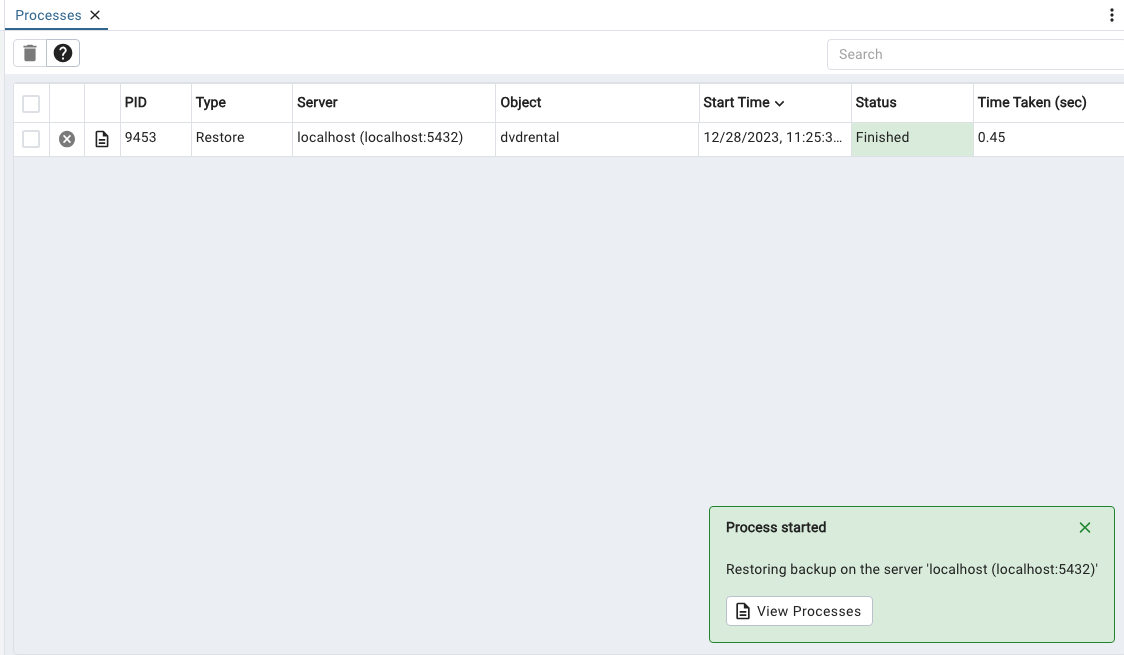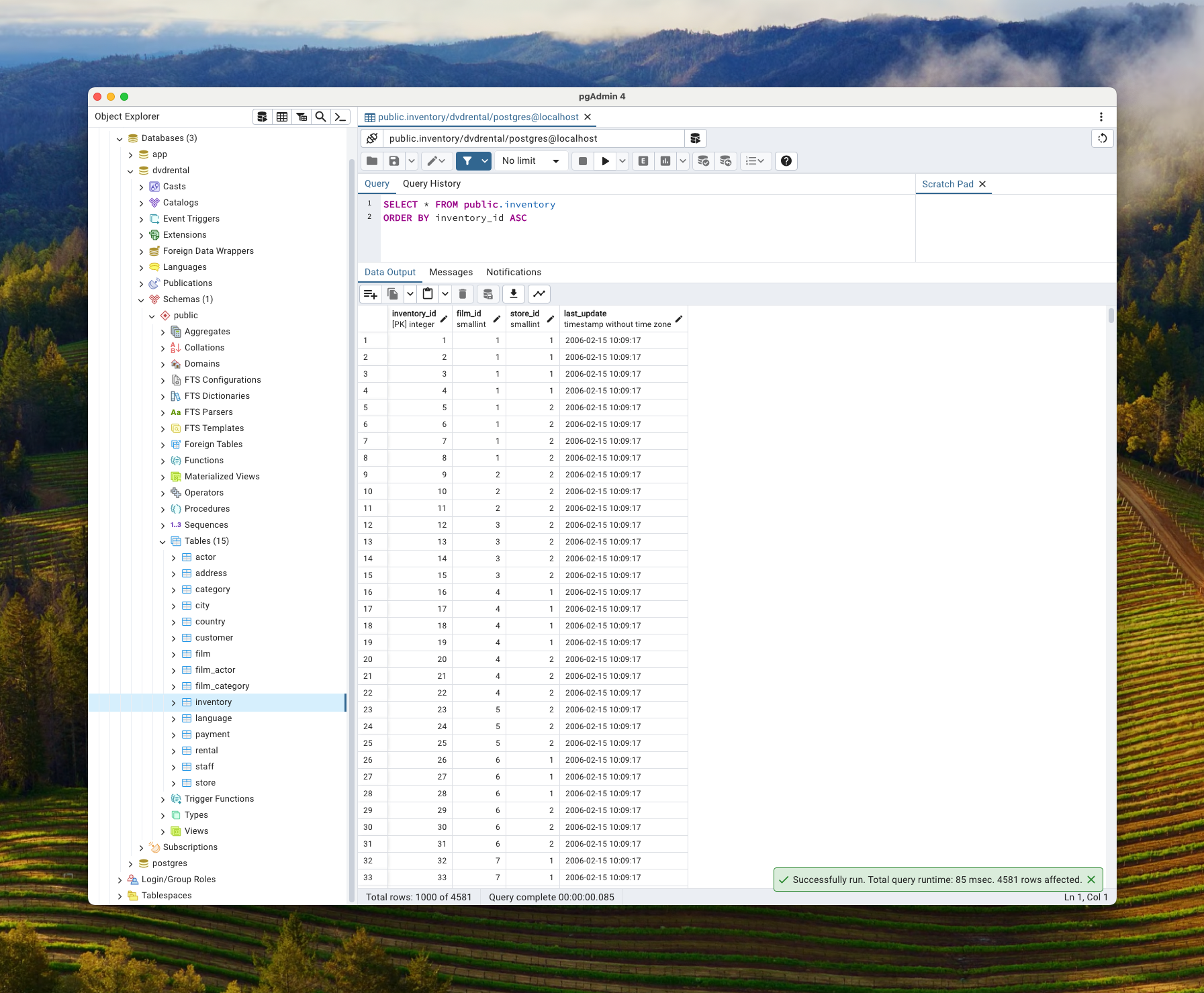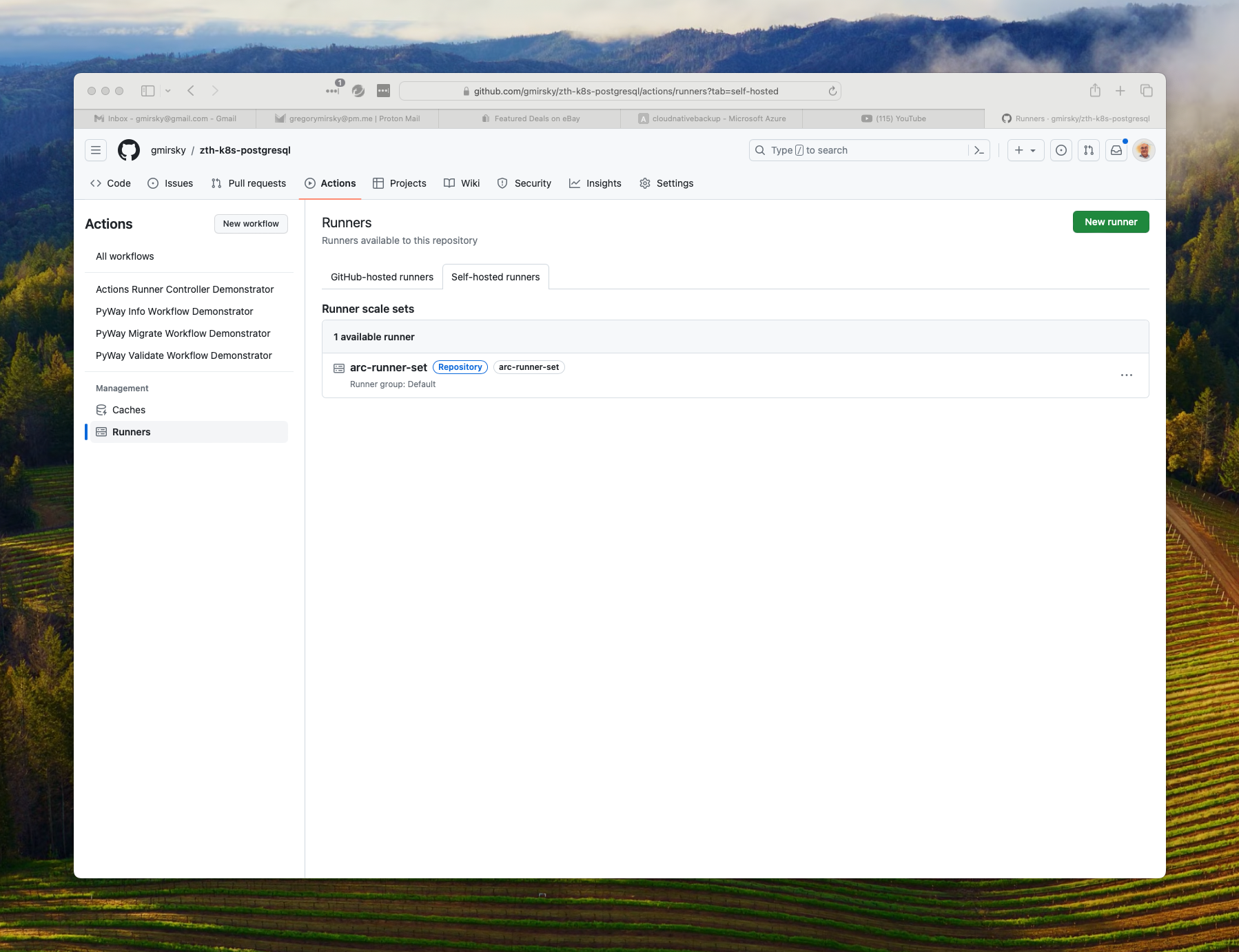Zero to Hero: Build a Azure AKS Kubernetes based PostgreSQL cluster with local GitHub Action Runners
Zero to Hero: This is a fully detailed step-by-step tutorial, assuming minimal skills, that will build an Azure AKS Kubernetes cluster to host a PostgreSQL clustered database, controlled by CloudNativePG and utilize local GitHub Actions Runners to perform continuous integration / continuous deployment (CI/CD) with Python's PyWay.
The clustered Postgres database features continuous and scheduled backups to cloud based storage, monitoring with Prometheus and a Grafana dashboard. The tutorial will utilize an ingress-nginx controller so that your database, Prometheus and Grafana are available outside of your Kubernetes cluster.
This tutorial uses Kubectl, Krew, Azure CLI or AWS CLI, Helm, Base64, GitHub Workflows and pgAdmin. Not familiar with all of these? Don't worry. There are detailed step by step instructions for you to follow along with so you can learn by doing.
NOTE: The commands below were tested in a Zsh/Bash command line environment. Some of the commands like base64 will be executed differently in Windows / Powershell and you will need to adjust the syntax accordingly.
A Azure account to store the cluster automated and on-demand backups. This account will also host the Azure AKS cluster.
For Azure, if you do not have a resource group or storage account already set up you can use the following Azure CLI commands:
# log into your Azure account
az loginTake note of the value in homeTenantID in the JSON output. (IDs have been redacted.)
[
{
"cloudName": "AzureCloud",
"homeTenantId": "********-8496-4ddd-a787-************",
"id": "********-014c-4a5e-95fe-************",
"isDefault": true,
"managedByTenants": [],
"name": "Pay-as-you-go",
"state": "Enabled",
"tenantId": "********-8496-4ddd-a787-************",
"user": {
"name": "********@gmail.com",
"type": "user"
}
}
]# create the Azure resource group that will host the storage account for our backups
az group create -l eastus -n cluster-example-rg
# create the Azure resource group that will host the AKS cluster
az group create -l EastUS -n az-k8s-pg-rgYou should get "provisioningState": "Succeeded" in the output JSON
{
"id": "/subscriptions/********-014c-4a5e-95fe-************/resourceGroups/cluster-example-rg",
"location": "eastus",
"managedBy": null,
"name": "cluster-example-rg",
"properties": {
"provisioningState": "Succeeded"
},
"tags": null,
"type": "Microsoft.Resources/resourceGroups"
}Note: You cannot use dashes in the storage account name.
# create the Azure Storage Account
az storage account create -n clusterexamplesa -g cluster-example-rg -l eastusVerify in the voluminous JSON output that "provisioningState": "Succeeded", is present to determine if your storage account was created.
# create the Azure Storage Account Container
az storage container create -n clusterexample --account-name clusterexamplesa --auth-mode loginIf everything goes correctly we should get the following JSON.
{
"created": true
}# List Azure storage account containers
az storage container list --account-name clusterexamplesaThe output should look like this:
[
{
"deleted": null,
"encryptionScope": {
"defaultEncryptionScope": "$account-encryption-key",
"preventEncryptionScopeOverride": false
},
"immutableStorageWithVersioningEnabled": false,
"metadata": null,
"name": "clusterexample",
"properties": {
"etag": "\"0x8DC06E6A573068B\"",
"hasImmutabilityPolicy": false,
"hasLegalHold": false,
"lastModified": "2023-12-27T14:18:06+00:00",
"lease": {
"duration": null,
"state": "available",
"status": "unlocked"
},
"publicAccess": null
},
"version": null
}
]Get theAzure keys for the Storage Account so that our cluster can store its automated and on demand backup to the Azure Storage Account Blob Container we just created.
# Get the storage account key list for our storage account
az storage account keys list --account-name clusterexamplesa --resource-group cluster-example-rgYou should get an access key back in the following form. (The keys below have been redacted.) Make a note of this key. You will need it later.
[
{
"creationTime": "2023-12-27T17:51:34.896182+00:00",
"keyName": "key1",
"permissions": "FULL",
"value": "y+U5+9dS************************************************************Ryx0k4+ASt0iuHlQ=="
},
{
"creationTime": "2023-12-27T14:03:44.634621+00:00",
"keyName": "key2",
"permissions": "FULL",
"value": "TfdkgSUY**********************************************************sQwHJozs+AStQwEe0g=="
}
]
To get the first key's value use the following:
# retrieve the first storage account key
az storage account keys list --account-name clusterexamplesa --resource-group cluster-example-rg --query "[0].value"
"y+U5+9dS************************************************************Ryx0k4+ASt0iuHlQ=="
# retrieve the second storage account key
az storage account keys list --account-name clusterexamplesa --resource-group cluster-example-rg --query "[1].value"
"jrBS+964************************************************************Qyx0k4+ASu0tuH1V=="Save the keys for later use.
Install Kubectl if it is not already installed, see installing Kubectl
Hint: If you have Docker Desktop, enabling the Kubernetes option in settings will install Kubectl for you.
# get the current version of our kubectl client and the version of our kubernetes cluster
kubectl version
Client Version: v1.29.1
Kustomize Version: v5.0.4-0.20230601165947-6ce0bf390ce3The Cloud Native Kubectl plugin is needed to generate the Postgres Operator. See installing Krew on how to install this plug in.
# get the version of the krew kubectl plugin
kubectl krew version
OPTION VALUE
GitTag v0.4.4
GitCommit 343e657d
IndexURI https://github.com/kubernetes-sigs/krew-index.git
BasePath /Users/gregorymirsky/.krew
IndexPath /Users/gregorymirsky/.krew/index/default
InstallPath /Users/gregorymirsky/.krew/store
BinPath /Users/gregorymirsky/.krew/bin
DetectedPlatform darwin/arm64Helm is required for chart installation. See installing Helm
# verify the Helm version installed
helm version
version.BuildInfo{Version:"v3.14.0", GitCommit:"3fc9f4b2638e76f26739cd77c7017139be81d0ea", GitTreeState:"clean", GoVersion:"go1.21.6"}pgAdmin should be installed on your host system to connect to the databases. See installing pgAdmin
Install base64 (on Linux) is included in coreutils. Use your distribution's package manager to install coreutils.
Install base64 (on Mac)
# Install base64
brew install base64Install base64 (on Windows) using PowerShell
# Install base64
Install-Module -Name Base64Verify the Base64 version
# check the base64 version
base64 --version
base64 1.5
Last revised: 10th June 2007
The latest version is always available
at http://www.fourmilab.ch/webtools/base64# Install the Krew Kubectl plugin
kubectl krew install cnpg# Check the cnpg plugin and check the version
kubectl cnpg version
Build: {Version:1.22.0 Commit:86b9dc80 Date:2023-12-21}# Update krew plugin
kubectl krew upgrade# Update cnpg plugin
kubectl krew upgrade cnpg# find your external IP address so that you can allow yourself access to your AKS cluster
dig @resolver3.opendns.com myip.opendns.com +short
108.29.92.98If you are using Windows / PowerShell you can use the following command:
# (Windows) Find your external IP address for the az deployment command
$(Resolve-DnsName myip.opendns.com -Server resolver3.opendns.com).IPAddress
108.29.92.98Use the following command to deploy the AKS single node cluster. For this tutorial all we need is a bare bones Kubernetes cluster.
All of this code is in the Azure subdirectory of this repository. Make sure that you are in the Azure subdirectory when you execute this command. Replace 108.29.92.98 with your external IP address you received from the dig or Resolve-DnsName command above.
# Deploy template with in-line parameters
# place your external IP address in the authorizedIPRanges parameter
az deployment group create -g az-k8s-pg-rg \
--template-file main.json \
--parameters \
resourceName=az-k8s-poc \
managedNodeResourceGroup=az-k8s-poc-mrg \
agentCount=1 \
upgradeChannel=stable \
JustUseSystemPool=true \
osDiskType=Managed \
osDiskSizeGB=32 \
authorizedIPRanges="[\"108.29.92.98/32\"]" \
ingressApplicationGateway=trueThis process can take some time. Be patient.
# Get credentials for your new AKS cluster & login (interactive)
az aks get-credentials -g az-k8s-pg-rg -n aks-az-k8s-pocStarting with our clean AKS Kubernetes cluster, let's get an idea of what is running already in the cluster before we begin.
# See what nodes we have running in our docker desktop kubernetes cluster
kubectl get nodes
NAME STATUS ROLES AGE VERSION
aks-npuser01-28117263-vmss000000 Ready control-plane 16h v1.28.2See what is running on the node.
# See what is running in our Kubernetes cluseter
kubectl get all --all-namespaces
NAMESPACE NAME READY STATUS RESTARTS AGE
kube-system pod/azure-ip-masq-agent-2k58t 1/1 Running 0 7m12s
kube-system pod/cloud-node-manager-2mmlr 1/1 Running 0 7m12s
kube-system pod/coredns-76b9877f49-6kgsj 1/1 Running 0 6m58s
kube-system pod/coredns-76b9877f49-xx85r 1/1 Running 0 7m24s
kube-system pod/coredns-autoscaler-85f7d6b75d-fttq7 1/1 Running 0 7m24s
kube-system pod/csi-azuredisk-node-mnp9j 3/3 Running 0 7m12s
kube-system pod/csi-azurefile-node-dl2w2 3/3 Running 0 7m12s
kube-system pod/ingress-appgw-deployment-7dc8d67679-dhc89 1/1 Running 0 7m23s
kube-system pod/konnectivity-agent-654d757cdc-6cfqc 1/1 Running 0 6m53s
kube-system pod/konnectivity-agent-654d757cdc-d9gmt 1/1 Running 0 7m14s
kube-system pod/kube-proxy-474cm 1/1 Running 0 7m12s
kube-system pod/metrics-server-c456c67cb-cwfd5 2/2 Running 0 6m53s
kube-system pod/metrics-server-c456c67cb-rsvd8 2/2 Running 0 6m53s
NAMESPACE NAME TYPE CLUSTER-IP EXTERNAL-IP PORT(S) AGE
default service/kubernetes ClusterIP 172.10.0.1 <none> 443/TCP 7m47s
kube-system service/kube-dns ClusterIP 172.10.0.10 <none> 53/UDP,53/TCP 7m24s
kube-system service/metrics-server ClusterIP 172.10.113.40 <none> 443/TCP 7m23s
NAMESPACE NAME DESIRED CURRENT READY UP-TO-DATE AVAILABLE NODE SELECTOR AGE
kube-system daemonset.apps/azure-ip-masq-agent 1 1 1 1 1 <none> 7m24s
kube-system daemonset.apps/cloud-node-manager 1 1 1 1 1 <none> 7m24s
kube-system daemonset.apps/cloud-node-manager-windows 0 0 0 0 0 <none> 7m24s
kube-system daemonset.apps/csi-azuredisk-node 1 1 1 1 1 <none> 7m24s
kube-system daemonset.apps/csi-azuredisk-node-win 0 0 0 0 0 <none> 7m24s
kube-system daemonset.apps/csi-azurefile-node 1 1 1 1 1 <none> 7m24s
kube-system daemonset.apps/csi-azurefile-node-win 0 0 0 0 0 <none> 7m24s
kube-system daemonset.apps/kube-proxy 1 1 1 1 1 <none> 7m23s
NAMESPACE NAME READY UP-TO-DATE AVAILABLE AGE
kube-system deployment.apps/coredns 2/2 2 2 7m24s
kube-system deployment.apps/coredns-autoscaler 1/1 1 1 7m24s
kube-system deployment.apps/ingress-appgw-deployment 1/1 1 1 7m23s
kube-system deployment.apps/konnectivity-agent 2/2 2 2 7m23s
kube-system deployment.apps/metrics-server 2/2 2 2 7m23s
NAMESPACE NAME DESIRED CURRENT READY AGE
kube-system replicaset.apps/coredns-76b9877f49 2 2 2 7m24s
kube-system replicaset.apps/coredns-autoscaler-85f7d6b75d 1 1 1 7m24s
kube-system replicaset.apps/ingress-appgw-deployment-7dc8d67679 1 1 1 7m23s
kube-system replicaset.apps/konnectivity-agent-654d757cdc 2 2 2 7m14s
kube-system replicaset.apps/konnectivity-agent-9b9db5545 0 0 0 7m23s
kube-system replicaset.apps/metrics-server-576b777cd4 0 0 0 7m23s
kube-system replicaset.apps/metrics-server-c456c67cb 2 2 2 6m53sWe will only need the dev namespace for this tutorial. The higher environments, qa, beta and prod are all optional that you can create later and deploy PostgreSQL clusters into.
# Create a new namespace called 'dev'
kubectl create namespace dev --dry-run=client -o yaml | kubectl apply -f -# List out the namespaces in the kube
kubectl get namespaces --all-namespaces --show-labels
NAME STATUS AGE LABELS
default Active 8m40s kubernetes.io/metadata.name=default
dev Active 11s kubernetes.io/metadata.name=dev
kube-node-lease Active 8m43s kubernetes.io/metadata.name=kube-node-lease
kube-public Active 8m43s kubernetes.io/metadata.name=kube-public
kube-system Active 8m43s addonmanager.kubernetes.io/mode=Reconcile,control-plane=true,kubernetes.azure.com/managedby=aks,kubernetes.io/cluster-service=true,kubernetes.io/metadata.name=kube-systemMake sure you are back in the root directory of the repository where the YAML files are.
Generate the operator CloudNativePG controller YAML manifest. The -n flag defines the namespace where the operator is deployed to and the replicas flag tells us how many replicas of the operator should be installed (note: number of operator replicas - not Postgres instances). For our demonstration we will pick one node but in production we would likely have 3, one for each cloud availability zone in the region.
# Generate the YAML manifest with 1 node to deploy
kubectl cnpg install generate -n devops-system --replicas 1 > operator-manifests.yaml# Apply the YAML file to deploy the CloudNativePG Operator
# No namespace is required since it is coded in the generated YAML file
kubectl apply -f operator-manifests.yamlYou should get output like this:
namespace/devops-system created
customresourcedefinition.apiextensions.k8s.io/backups.postgresql.cnpg.io created
customresourcedefinition.apiextensions.k8s.io/clusters.postgresql.cnpg.io created
customresourcedefinition.apiextensions.k8s.io/poolers.postgresql.cnpg.io created
customresourcedefinition.apiextensions.k8s.io/scheduledbackups.postgresql.cnpg.io created
serviceaccount/cnpg-manager created
clusterrole.rbac.authorization.k8s.io/cnpg-manager created
clusterrolebinding.rbac.authorization.k8s.io/cnpg-manager-rolebinding created
configmap/cnpg-default-monitoring created
service/cnpg-webhook-service created
deployment.apps/cnpg-controller-manager created
mutatingwebhookconfiguration.admissionregistration.k8s.io/cnpg-mutating-webhook-configuration created
validatingwebhookconfiguration.admissionregistration.k8s.io/cnpg-validating-webhook-configuration created# Check to see if the CloudNativePG Operator deployment deployed successfully
kubectl get deployment -n devops-system cnpg-controller-manager --show-labelsYou should get output like this when the cnpg-controller-manager is available and ready:
NAME READY UP-TO-DATE AVAILABLE AGE LABELS
cnpg-controller-manager 1/1 1 1 24s app.kubernetes.io/name=cloudnative-pgWe will need to provision secrets to our Kubernetes cluster that the other resources that we later will provision can utilize.
Passwords are base64 encoded.
To encode a password use the Base64 Encode website so you do not have to worry about character sets and other frustrating nuances of Base64 encoding. Just make sure that your destination character set is UTF-8 and the destination new line separator is set to LF(Unix).
For our example cluster, we will create an app user using the cluster-example-app-user.yaml file. Our sample password is Postgres and our sample user name is app.
In production, you would use stronger passwords and not code the password into the YAML file.
data:
# postgres
password: cG9zdGdyZXM=
# app
username: YXBw
kind: Secret
metadata:
name: cluster-example-app-user
labels: {
"secret-type" : "app-user"
}
type: kubernetes.io/basic-authTo apply the secret to our dev namespace we use the following command.
# Create the cluster-example-app-user secret
kubectl apply -f cluster-example-app-user.yaml -n devCheck to see if our secret is there:
# Check the secrets in the dev namespace
kubectl get secrets -n dev
NAME TYPE DATA AGE
cluster-example-app-user kubernetes.io/basic-auth 2 18sCreate a super user for the PostgreSQL cluster to executer elevated privileged functions. Here, our user must be Postgres and the password, again, is Postgres for our example.
apiVersion: v1
data:
# postgres
password: cG9zdGdyZXM=
# must always be postgres
username: cG9zdGdyZXM=
kind: Secret
metadata:
name: cluster-example-superuser
labels: {
"secret-type" : "database-super-user"
}
type: kubernetes.io/basic-authTo apply the secret to our dev namespace we use the following command.
# Create the cluster-example-superuser secret
kubectl apply -f cluster-example-superuser.yaml -n devVerify that the secret we just applied was created:
# Check the secrets in the dev namespace
kubectl get secrets -n dev
NAME TYPE DATA AGE
cluster-example-app-user kubernetes.io/basic-auth 2 2m17s
cluster-example-superuser kubernetes.io/basic-auth 2 3sAnother way to create credentials is directly from the kubectl command line.
Here we will create our Azure credentials for our Kubernetes PostgreSQL cluster to back up data to. For obvious reasons, we do not want to save this information to a YAML file, so we enter the credentials only from the command line.
The Azure Storage Key is the value you saved from above when you created the storage account and container.
# Create a kubernetes secret in namespace dev to hold our Azure credentials
kubectl create secret generic azure-creds -n dev \
--from-literal=AZURE_STORAGE_ACCOUNT="<storage account name>" \
--from-literal=AZURE_STORAGE_KEY="<Storage Key save previously>" Confirm the creation of the secret.
# Get the secrets in namespace dev
kubectl get secrets -n dev
NAME TYPE DATA AGE
azure-creds Opaque 2 11s
cluster-example-app-user kubernetes.io/basic-auth 2 94m
cluster-example-superuser kubernetes.io/basic-auth 2 91mNow let's add a label to the secret to denote what tenant it belongs to. (Note: Use your Azure tenant ID) Labels can be anything you wish.
# get the Azure tenant id
az account show --query "tenantId"
# Label the secret
kubectl label secret azure-creds -n dev "azure-tenant=00000000-0000-0000-0000-000000000000" List out the secrets with their labels.
# Get the secrets with their labels in namespace dev
kubectl get secrets -n dev --show-labels
NAME TYPE DATA AGE LABELS
azure-creds Opaque 2 28m azure-tenant=00000000-0000-0000-0000-000000000000
cluster-example-app-user kubernetes.io/basic-auth 2 122m secret-type=app-user
cluster-example-superuser kubernetes.io/basic-auth 2 120m secret-type=database-super-userVerify that the keys were stored properly and can be decrypted and they produce the values you provided.
For the Azure credentials, use the following commands:
# Verify that you can decrypt the Azure Storage Account in namespace dev
kubectl get secret azure-creds -o 'jsonpath={.data.AZURE_STORAGE_ACCOUNT}' -n dev | base64 --decode
# Verify that you can decrypt the Azure Storage Account in namespace dev
kubectl get secret azure-creds -o 'jsonpath={.data.AZURE_STORAGE_KEY}' -n dev | base64 --decodeBefore deploying, check that cluster-example.yaml has the proper configuration for your environment.
You will need to change the name of the Azure storage account in the destinationPath to the one you deployed in your Azure account.
For Azure make sure that the destinationPath in the backup section matches the path to your container. Use the combination of credentials that suits your environment the best.
In order to access the storage account, you will need one of the following combinations of credentials:
- Connection String
- Storage account name and Storage account access key
- Storage account name and Storage account SAS Token
- Storage account name and Azure AD Workload Identity properly configured.
For this tutorial, we are using the storage account name and the storage account key.
backup:
barmanObjectStore:
destinationPath: "https://clusterexamplesa.blob.core.windows.net/cloudnativebackup"
azureCredentials:
# connectionString:
# name: azure-creds
# key: AZURE_CONNECTION_STRING
storageAccount:
name: azure-creds
key: AZURE_STORAGE_ACCOUNT
storageKey:
name: azure-creds
key: AZURE_STORAGE_KEY
# storageSasToken:
# name: azure-creds
# key: AZURE_STORAGE_SAS_TOKEN
Now that all the secrets are in place, we will now deploy a PostgreSQL cluster into the dev namespace.
The cluster will have a master and two replicas. One replica is for read-only transactions and the other replica is used by the continuous backup facilities.
# Deploy a Postgresql cluster into the dev namespace
kubectl apply -f cluster-example.yaml -n dev# Check the status of the cluster
kubectl cnpg status -n dev cluster-example
# Check the status of the cluster with verbose on
kubectl cnpg status -n dev cluster-example -vThis is what you should see initially as output:
Cluster Summary
Primary server is initializing
Name: cluster-example
Namespace: dev
PostgreSQL Image: ghcr.io/cloudnative-pg/postgresql:16.0
Primary instance: (switching to cluster-example-1)
Status: Setting up primary Creating primary instance cluster-example-1
Instances: 3
Ready instances: 0
Certificates Status
Certificate Name Expiration Date Days Left Until Expiration
---------------- --------------- --------------------------
cluster-example-ca 2024-03-17 14:18:14 +0000 UTC 90.00
cluster-example-replication 2024-03-17 14:18:14 +0000 UTC 90.00
cluster-example-server 2024-03-17 14:18:14 +0000 UTC 90.00
Continuous Backup status
Not configured
Physical backups
Primary instance not found
Streaming Replication status
Primary instance not found
Unmanaged Replication Slot Status
No unmanaged replication slots found
Instances status
Name Database Size Current LSN Replication role Status QoS Manager Version Node
---- ------------- ----------- ---------------- ------ --- --------------- ----
Error: container not foundThis is what you should see when the cluster has been fully deployed:
kubectl cnpg status -n dev cluster-example ─
Cluster Summary
Name: cluster-example
Namespace: dev
System ID: 7315093927430983701
PostgreSQL Image: ghcr.io/cloudnative-pg/postgresql:16.1
Primary instance: cluster-example-1
Primary start time: 2023-12-21 17:00:33 +0000 UTC (uptime 18m23s)
Status: Cluster in healthy state
Instances: 3
Ready instances: 3
Current Write LSN: 0/8000000 (Timeline: 1 - WAL File: 000000010000000000000007)
Certificates Status
Certificate Name Expiration Date Days Left Until Expiration
---------------- --------------- --------------------------
cluster-example-ca 2024-03-20 16:55:06 +0000 UTC 89.98
cluster-example-replication 2024-03-20 16:55:06 +0000 UTC 89.98
cluster-example-server 2024-03-20 16:55:06 +0000 UTC 89.98
Continuous Backup status
First Point of Recoverability: Not Available
Working WAL archiving: OK
WALs waiting to be archived: 0
Last Archived WAL: 000000010000000000000007 @ 2023-12-21T17:11:04.891528Z
Last Failed WAL: -
Physical backups
No running physical backups found
Streaming Replication status
Replication Slots Enabled
Name Sent LSN Write LSN Flush LSN Replay LSN Write Lag Flush Lag Replay Lag State Sync State Sync Priority Replication Slot
---- -------- --------- --------- ---------- --------- --------- ---------- ----- ---------- ------------- ----------------
cluster-example-2 0/8000000 0/8000000 0/8000000 0/8000000 00:00:00 00:00:00 00:00:00 streaming async 0 active
cluster-example-3 0/8000000 0/8000000 0/8000000 0/8000000 00:00:00 00:00:00 00:00:00 streaming async 0 active
Unmanaged Replication Slot Status
No unmanaged replication slots found
Managed roles status
No roles managed
Tablespaces status
No managed tablespaces
Instances status
Name Database Size Current LSN Replication role Status QoS Manager Version Node
---- ------------- ----------- ---------------- ------ --- --------------- ----
cluster-example-1 29 MB 0/8000000 Primary OK BestEffort 1.22.0 docker-desktop
cluster-example-2 29 MB 0/8000000 Standby (async) OK BestEffort 1.22.0 docker-desktop
cluster-example-3 29 MB 0/8000000 Standby (async) OK BestEffort 1.22.0 docker-desktopAt this point, our CloudNativePG PostgreSQL cluster should be deployed.
We will install the CloudNativePG built in monitoring solution using Prometheus and Grafana to monitor our PostgreSQL clusters. Prometheus will automatically pick up monitoring data from any CNPG PostgreSQL database in the AKS cluster that has the following stanza in its deployment YAML.
monitoring:
enablePodMonitor: trueWe will use Helm to install the monitoring.
# Check to see what Helm charts are in your local Helm repository
helm repo list
# Update the Helm charts in your repositories (if any)
helm repo update
# Add the Prometheus Community Helm chart to your local Helm repository (if not already installed)
helm repo add prometheus-community https://prometheus-community.github.io/helm-charts
# Install Prometheus monitoring using the Helm chart we just added
helm upgrade --install -f https://raw.githubusercontent.com/cloudnative-pg/cloudnative-pg/main/docs/src/samples/monitoring/kube-stack-config.yaml prometheus-community prometheus-community/kube-prometheus-stack -n devops-system
# Check to see if Prometheus is running correctly
kubectl --namespace devops-system get pods -l "release=prometheus-community"# Install CNPG sample Prometheus monotring rules
kubectl apply -f https://raw.githubusercontent.com/cloudnative-pg/cloudnative-pg/main/docs/src/samples/monitoring/prometheusrule.yaml -n devops-system Grafana is installed with Prometheus. Below, we will install a monitoring dashboard that provides comprehensive details on our clusters.
# Install Graphana so we can use dashboards to report Prometheus data
kubectl apply -f https://raw.githubusercontent.com/cloudnative-pg/cloudnative-pg/main/docs/src/samples/monitoring/grafana-configmap.yaml -n devops-system Assuming that the command kubectl cnpg status -n dev cluster-example returns a value of Working WAL archiving: OK we can initiate a manual back up of the cluster by using the YAML in cluster-example-on-demand-backup.yaml
apiVersion: postgresql.cnpg.io/v1
kind: Backup
metadata:
name: cluster-example-on-demand-backup
spec:
method: barmanObjectStore
cluster:
name: cluster-exampleNOTE: Backups occur from the most in-sync replica. If neither replica is in-sync then the backup is made from the primary node.
# Initiate a manual back up on the postgres cluster in namespace dev
kubectl apply -f cluster-example-on-demand-backup.yaml -n dev# Check the status of the on-demand backup
kubectl describe backup cluster-example-on-demand-backup -n dev
Name: cluster-example-on-demand-backup
Namespace: dev
Labels: <none>
Annotations: <none>
API Version: postgresql.cnpg.io/v1
Kind: Backup
Metadata:
Creation Timestamp: 2023-12-27T20:13:28Z
Generation: 1
Resource Version: 48184
UID: 9035cd3d-87c3-4a09-a751-47d4ee946ee2
Spec:
Cluster:
Name: cluster-example
Method: barmanObjectStore
Status:
Azure Credentials:
Storage Account:
Key: AZURE_STORAGE_ACCOUNT
Name: azure-creds
Storage Key:
Key: AZURE_STORAGE_KEY
Name: azure-creds
Backup Id: 20231227T201329
Backup Name: backup-20231227201328
Begin LSN: 0/60538C8
Begin Wal: 000000010000000000000006
Destination Path: https://clusterexamplesa.blob.core.windows.net/cloudnativebackup
End LSN: 0/8000000
End Wal: 000000010000000000000008
Instance ID:
Container ID: docker://fe66eab7eca14d0094b4ad102658501ef220d6f003c56d820ef75673fd2d6a42
Pod Name: cluster-example-2
Method: barmanObjectStore
Phase: completed
Server Name: cluster-example
Started At: 2023-12-27T20:13:29Z
Stopped At: 2023-12-27T20:13:30Z
Events:
Type Reason Age From Message
---- ------ ---- ---- -------
Normal Starting 44s cloudnative-pg-backup Starting backup for cluster cluster-example
Normal Starting 44s instance-manager Backup started
Normal Completed 42s instance-manager Backup completedWe now have a baseline backup of our cluster.
If our manual backup succeeded, then we can create a scheduled backup. Manual and scheduled backups are in addition to the continuous backups.
We will use the cluster-example-scheduled-backup.yam file to create a scheduled backup job. This will create a backup every two hours at five minutes past the hour.
apiVersion: postgresql.cnpg.io/v1
kind: ScheduledBackup
metadata:
name: cluster-example-scheduled-backup
spec:
# Backup every two hours at 5 minutes past the hour
schedule: "0 5 */2 * * *"
backupOwnerReference: self
cluster:
name: cluster-example# Initiate an automated back up on the postgres cluster in namespace dev
kubectl apply -f cluster-example-scheduled-backup.yaml -n dev # Check the status of the scheduled backup
kubectl describe scheduledbackup cluster-example-scheduled-backup -n dev
Name: cluster-example-scheduled-backup
Namespace: dev
Labels: <none>
Annotations: <none>
API Version: postgresql.cnpg.io/v1
Kind: ScheduledBackup
Metadata:
Creation Timestamp: 2023-12-27T20:27:09Z
Generation: 1
Resource Version: 49698
UID: 648c0bad-c669-4901-84ff-fa6de28db5d8
Spec:
Backup Owner Reference: self
Cluster:
Name: cluster-example
Method: barmanObjectStore
Schedule: 0 5 */2 * * *
Status:
Last Check Time: 2023-12-27T20:27:09Z
Events:
Type Reason Age From Message
---- ------ ---- ---- -------
Normal BackupSchedule 3m35s cloudnative-pg-scheduledbackup Scheduled first backup by 2023-12-27 22:05:00 +0000 UTCYou can display the data backed up in your Azure Storage Account Container with the following AZ CLI command:
az storage blob list --account-name clusterexamplesa --container-name cloudnativebackup --query "[*].name" --only-show-errors
[
"cluster-example/base/20231228T140031/backup.info",
"cluster-example/base/20231228T140031/data.tar",
"cluster-example/base/20231228T140500/backup.info",
"cluster-example/base/20231228T140500/data.tar",
"cluster-example/base/20231228T160500/backup.info",
"cluster-example/base/20231228T160500/data.tar",
"cluster-example/wals/0000000100000000/000000010000000000000001.snappy",
"cluster-example/wals/0000000100000000/000000010000000000000002.snappy",
"cluster-example/wals/0000000100000000/000000010000000000000003.snappy",
"cluster-example/wals/0000000100000000/000000010000000000000003.00000028.backup.snappy",
"cluster-example/wals/0000000100000000/000000010000000000000004.snappy",
"cluster-example/wals/0000000100000000/000000010000000000000005.snappy",
"cluster-example/wals/0000000100000000/000000010000000000000005.00000028.backup.snappy",
"cluster-example/wals/0000000100000000/000000010000000000000006.snappy",
"cluster-example/wals/0000000100000000/000000010000000000000007.snappy",
"cluster-example/wals/0000000100000000/000000010000000000000008.snappy",
"cluster-example/wals/0000000100000000/000000010000000000000009.snappy",
"cluster-example/wals/0000000100000000/00000001000000000000000A.snappy",
"cluster-example/wals/0000000100000000/00000001000000000000000B.snappy",
"cluster-example/wals/0000000100000000/00000001000000000000000C.snappy",
"cluster-example/wals/0000000100000000/00000001000000000000000D.snappy",
"cluster-example/wals/0000000100000000/00000001000000000000000E.snappy"Often, we will want to expose the database to other servers outside of the Kubernetes cluster. There are many ways to do this depending upon your Kubernetes deployment and organization standards.
Many cloud based Kubernetes clusters come with their own proprietary ingress controllers. For this example we will use the ingress-nginx controller to expose our database and the associated monitoring websites.
Important: Ingresses are only required to expose HTTP and HTTPS traffic. While the NGINX Ingress controller can, not all Ingress objects can expose arbitrary ports or protocols like port 5432.
For our AKS deployment, our ingress-nginx controller will make the underlying services that front end the actual pods available outside of our AKS cluster. Our AKS deployment comes with a load balancer that then picks up the port combinations exposed by the ingress-nginx controller and makes them available to the public IP of the balancer.
Install the ingress-nginx controller by adding the Helm repository to our local Helm libraries.
# Add Ingress-Nginx to our local Helm repository
helm repo add ingress-nginx https://kubernetes.github.io/ingress-nginx Check that it was added.
# List the Helm repos to verify that it was added
helm repo listGet the name of the services for the PostgresSQL cluster.
# Get the services that belong to our cluster in namespace dev
kubectl get services -n dev -l cnpg.io/cluster=cluster-example
NAME TYPE CLUSTER-IP EXTERNAL-IP PORT(S) AGE
cluster-example-r ClusterIP 10.110.243.89 <none> 5432/TCP 4h28m
cluster-example-ro ClusterIP 10.102.152.52 <none> 5432/TCP 4h28m
cluster-example-rw ClusterIP 10.106.64.120 <none> 5432/TCP 4h28mGet the Grafana/Prometheus service also.
# Get the Grafana service
kubectl get services -n devops-system -l app.kubernetes.io/name=grafana
NAME TYPE CLUSTER-IP EXTERNAL-IP PORT(S) AGE
prometheus-community-grafana ClusterIP 10.103.92.32 <none> 80/TCP 119m
kubectl get services -n devops-system -l operated-prometheus=true
NAME TYPE CLUSTER-IP EXTERNAL-IP PORT(S) AGE
prometheus-operated ClusterIP None <none> 9090/TCP 22m
Install the Nginx controller with the dev/cluster-example-rw service mapped to port 5432. This is our primary node that has read and write access to the PostgreSQL database cluster.
We will map dev/cluster-example-ro to port 5433 /cluster-example-r mapped to port 5434. We can't have these services using the same port as the read/write node of the PostgreSQL database cluster. If you wish to have applications just access the read only replica of the PostgreSQL database cluster then point them to port 5433. The final service is generally used by the backup process to backup data but it too can be used as a read only node.
We will also map the Grafana web interface to port 8083 and the Prometheus web interface to port 9090.
# Install the Nginx Ingress controller
helm upgrade --install ingress-nginx ingress-nginx \
--repo https://kubernetes.github.io/ingress-nginx \
--namespace ingress-nginx \
--create-namespace \
--set controller.replicaCount=2 \
--set tcp.5432="dev/cluster-example-rw:5432" \
--set tcp.5433="dev/cluster-example-ro:5432" \
--set tcp.5434="dev/cluster-example-r:5432" \
--set tcp.8083="devops-system/prometheus-community-grafana:80" \
--set tcp.9090="devops-system/prometheus-community-kube-prometheus:9090"Your output should look something like this:
Release "ingress-nginx" does not exist. Installing it now.
NAME: ingress-nginx
LAST DEPLOYED: Thu Dec 28 10:37:39 2023
NAMESPACE: ingress-nginx
STATUS: deployed
REVISION: 1
TEST SUITE: None
NOTES:
The ingress-nginx controller has been installed.
It may take a few minutes for the load balancer IP to be available.
You can watch the status by running 'kubectl get service --namespace ingress-nginx ingress-nginx-controller --output wide --watch'
An example Ingress that makes use of the controller:
apiVersion: networking.k8s.io/v1
kind: Ingress
metadata:
name: example
namespace: foo
spec:
ingressClassName: nginx
rules:
- host: www.example.com
http:
paths:
- pathType: Prefix
backend:
service:
name: exampleService
port:
number: 80
path: /
# This section is only required if TLS is to be enabled for the Ingress
tls:
- hosts:
- www.example.com
secretName: example-tls
If TLS is enabled for the Ingress, a Secret containing the certificate and key must also be provided:
apiVersion: v1
kind: Secret
metadata:
name: example-tls
namespace: foo
data:
tls.crt: <base64 encoded cert>
tls.key: <base64 encoded key>
type: kubernetes.io/tlsUsing your Azure portal, navigate to the managed resource group (usually the same name as the resource group you specified for the AKS cluster but ending in -mrg) and find the load balancer (it is usually named Kubernetes) and drill down to the Frontend IP Configuration as shown below.
Since our Helm request to provision the ingress-nginx controller had specified five (5) ports to be forwarded and the ingress-nginx controller automatically provisions rules for port 80 (http) and port 443 (https) the rule count would be seven (7).
As you can see, there is a IP address for the front end. In our example it is 4.156.216.212
If we click on the blue frontend IP name we can see the details that include the ports we specified along with ports 80 and 443.
So IP address 4.156.216.212 is the address of our load balancer.
We should be able to access the Grafana web user interface using http://4.156.216.212:8083 to open up the Grafana web interface.
Now, let's go to http://4.156.216.212:9090 and open up the Prometheus web interface.
Now let's open up the Grafana web interface at http://4.156.216.212 Log in with the user ID admin and the password prom-operator and navigate to dashboards.
Open the CloudNativePG dashboard.
Scroll down and investigate the hundreds of parameters Prometheus captures about the PostgreSQL databases.
Open up your local installation of pgAdmin. Once connected to pgAdmin click on the Add Server quick link.
In the General tab, for Name, put a meaningful name for you. Below we put cluster-example.
On the Connection tab, for Hostname address we put in the IP address from the load balancer mentioned above. For Username put the super user name, Postgres (or you could have put the user name app). For password supply the proper password. Hit save to connect and save the connection.
After successful connection to the database you should see the navigation tree on the left hand side. There will be two databases, the Postgres system database and the app database that we defined when we created the cluster.
Using pgAdmin, right click on databases -> Create and create a database called dvdrental.
Right click on the database and select Restore
For format choose Directory and in the Filename select the dvdrental folder in this repository. Set the number of jobs to one (1) and then click the Restore button.
A small window will open in the lower left with a button View Processes, click on it to see your restore job status. This is a small restore so it will most likely be Finished by the time you see it displayed.
You can navigate back to the database tree and drill down on the dvdrental database. Pick a table and select View/Edit Rows -> All Rows to see the data.
Congratulations! You now have a fully functional database cluster that is monitored and backed up.
Since CloudNativePG can switch the primary pod, depending upon setup and environmental reasons, such as the primary pod malfunctions, you cannot assume the primary pod when the database was provisioned is still the primary node. You may need the primary pod for Kubernetes debugging or performance tuning.
To find the primary pod for the database in namespace dev use the following command:
# Get the primary database pod in namespace dev
kubectl get pods -o jsonpath={.items..metadata.name} -l cnpg.io/cluster=cluster-example,cnpg.io/instanceRole=primary -n dev
cluster-example-1%Setting up a database cluster and backing it up is only one facet of database administration. We will now set up in our cluster local self-hosted GitHub runners that will handle Continuous Integration / Continuous Delivery (CI/CD).
Prerequisite: Create a Personal Access Token (Classic) for your repository, See the GitHub documentation for more information. Also, create a repository secret called DATABASE_PASSWORD to house your database password.
Source SQL to be applied to the database is in the resources folder.
You can add the self hosted GitHub Actions Runner Controller (ARC) to your Kubernetes cluster to enable CI/CD actions using PyWay.
More information regarding Pyway can be found here
# Install the Helm chart for the GitHub Actions Runner Scale Set Controller
helm install arc --namespace "arc-systems" --create-namespace \
oci://ghcr.io/actions/actions-runner-controller-charts/gha-runner-scale-set-controller
# Set the variable for the installation name for the GitHub runners
INSTALLATION_NAME="arc-runner-set"
# Set the variable for the namespace name
NAMESPACE="arc-runners"
# Set the variable for the name of the GitHub repository that will trigger off
# the self hosted workflow action runners
GITHUB_CONFIG_URL="https://github.com/myaccount/my-fantastic-repository"
# Set the variable for the GitHub personal access token
GITHUB_PAT="****************************************"
# Install the Helm chart for GitHub Actions Runner Scale set
helm install "${INSTALLATION_NAME}" \
--namespace "${NAMESPACE}" \
--create-namespace \
--set githubConfigUrl="${GITHUB_CONFIG_URL}" \
--set githubConfigSecret.github_token="${GITHUB_PAT}" \
--set containerMode.type="dind" \
oci://ghcr.io/actions/actions-runner-controller-charts/gha-runner-scale-setYou can check if the local GitHub Actions runners were able to communicate with GitHub by checking the GitHub Actions Runners tab.
You can use this demonstration-workflow.yml to test the communication between your repository and your locally hosted runners. This workflow does nothing but print out some messages in the workflow. You can manually trigger this off via the GitHub Actions panel for the repository.
---
# This is a Actions Runner Controller Demonstrator
name: Actions Runner Controller Demonstrator
# Controls when the workflow will run
on:
# Triggers the workflow on push or pull request events but only for the "main" branch
# push:
# branches: [ "main" ]
# pull_request:
# branches: [ "main" ]
# Allows you to run this workflow manually from the Actions tab
workflow_dispatch:
# A workflow run is made up of one or more jobs that can run sequentially or in parallel
jobs:
# This workflow contains a single job called "build"
build:
# The type of runner that the job will run on
runs-on: arc-runner-set
# Steps represent a sequence of tasks that will be executed as part of the job
steps:
# Checks-out your repository under $GITHUB_WORKSPACE, so your job can access it
- uses: actions/checkout@v4
# Runs a single command using the runners shell
- name: Run a one-line script
run: echo "🎉 This job uses runner scale set runners!"To test the PyWay connectivity to your database in the cluster you can use the follow pyway-info.yml workflow. Remember to change the variables to match your deployment and to adjust the values for the database host and database port to match your deployment.
---
name: "PyWay Info Workflow Demonstrator"
# Controls when the action will run.
on:
# Allows you to run this workflow manually from the Actions tab
workflow_dispatch:
# Environment variables are used to pass secrets to the workflow
env:
database_type: postgres
database_username: postgres
database_password: ${{ secrets.DATABASE_PASSWORD }}
database_host: 4.156.216.212
database_port: 5432
database_name: app
database_table: public.pyway_history
# A workflow run is made up of one or more jobs that can run sequentially or in parallel
jobs:
# This workflow contains a single job called "pyway_info"
pyway_info:
strategy:
fail-fast: false
matrix:
os: [ubuntu-latest]
# The type of runner that the job will run on
runs-on: arc-runner-set
# Steps represent a sequence of tasks that will be executed as part of the job
steps:
# Checks-out your repository under $GITHUB_WORKSPACE, so your job can access it
- name: Checkout repository
uses: actions/checkout@v4
- name: Verify Matrix.OS
run: |
echo "Matrix.OS: ${{ matrix.os }}"
# Set up Python 3.12
# actions/setup-python doesn't yet support ARM. For ARM use deadsnakes/action@v3.1.0
- if: ${{ matrix.os == 'ubuntu-latest' }}
name: Set up Python 3.12 ubuntu-latest
uses: actions/setup-python@v2
with:
python-version: "3.12"
- name: Run PyWay Info
run: |
echo "Running PyWay Info Workflow Demonstrator"
echo "Repository: ${{ github.repository }}"
echo "GitHub Event Name: ${{ github.event_name }}"
echo "GitHub Event Path: ${{ github.event_path }}"
echo "GitHub Workspace: ${{ github.workspace }}"
python --version
echo "Upgrading pip"
python -m pip install --upgrade pip
echo "Installing PyWay"
pip install pyway
echo "Running PyWay Info"
echo "Environment variable database_type: ${{ env.database_type }}"
echo "Environment variable database_username: ${{ env.database_username }}"
echo "Environment variable database_host: ${{ env.database_host }}"
echo "Environment variable database_port: ${{ env.database_port }}"
echo "Environment variable database_name: ${{ env.database_name }}"
pyway info --database-type ${{ env.database_type }} --database-username ${{ env.database_username }} --database-password ${{ env.database_password }} --database-host ${{ env.database_host }} --database-port ${{ env.database_port }} --database-name ${{ env.database_name }} --database-table ${{ env.database_table }}
echo "PyWay Info Workflow Demonstrator finished."
NOTE: if the pyway table is not in the schema selected, pyway will create it whether you use the info, validate or migrate option.
If you check the workflow output, you will see output like this:
PyWay 0.3.21
Gathering info...
+-----------+-------------+----------------------------+------------+-------------------+
| version | extension | name | checksum | apply_timestamp |
|-----------+-------------+----------------------------+------------+-------------------|
| 1.01 | SQL | V01_01__initial_schema.sql | new | new |
+-----------+-------------+----------------------------+------------+-------------------+
In the repository, you will also find pyway-validate.yml and pyway-migrate.yml that are both variations of the above yaml file. As the names imply, pyway-validate.yml will validate the SQL in the resources directory of the repository. Think of it as a dry run.
---
name: "PyWay Validate Workflow Demonstrator"
# Controls when the action will run.
on:
# Allows you to run this workflow manually from the Actions tab
workflow_dispatch:
# Environment variables are used to pass secrets to the workflow
env:
database_type: postgres
database_username: postgres
database_password: ${{ secrets.DATABASE_PASSWORD }}
database_host: 4.156.216.212
database_port: 5432
database_name: app
database_table: public.pyway_history
# A workflow run is made up of one or more jobs that can run sequentially or in parallel
jobs:
# This workflow contains a single job called "pyway_validate"
pyway_validate:
strategy:
fail-fast: false
matrix:
os: [ubuntu-latest]
# The type of runner that the job will run on
runs-on: arc-runner-set
# Steps represent a sequence of tasks that will be executed as part of the job
steps:
# Checks-out your repository under $GITHUB_WORKSPACE, so your job can access it
- name: Checkout repository
uses: actions/checkout@v4
- name: Verify Matrix.OS
run: |
echo "Matrix.OS: ${{ matrix.os }}"
# Set up Python 3.12
# actions/setup-python doesn't yet support ARM. For ARM use deadsnakes/action@v3.1.0
- if: ${{ matrix.os == 'ubuntu-latest' }}
name: Set up Python 3.12 ubuntu-latest
uses: actions/setup-python@v2
with:
python-version: "3.12"
- name: Run PyWay Validate
run: |
echo "Running PyWay Validate Workflow Demonstrator"
echo "Repository: ${{ github.repository }}"
echo "GitHub Event Name: ${{ github.event_name }}"
echo "GitHub Event Path: ${{ github.event_path }}"
echo "GitHub Workspace: ${{ github.workspace }}"
python --version
echo "Upgrading pip"
python -m pip install --upgrade pip
echo "Installing PyWay"
pip install pyway
echo "Running PyWay Validate"
echo "Environment variable database_type: ${{ env.database_type }}"
echo "Environment variable database_username: ${{ env.database_username }}"
echo "Environment variable database_host: ${{ env.database_host }}"
echo "Environment variable database_port: ${{ env.database_port }}"
echo "Environment variable database_name: ${{ env.database_name }}"
pyway validate --database-type ${{ env.database_type }} --database-username ${{ env.database_username }} --database-password ${{ env.database_password }} --database-host ${{ env.database_host }} --database-port ${{ env.database_port }} --database-name ${{ env.database_name }} --database-table ${{ env.database_table }}
echo "PyWay Validate Workflow Demonstrator finished."
If you check the output for the validate workflow you will see the following output:
PyWay 0.3.21
Starting validation process
Validation completed.The pyway-migrate.yml file differs in that the "on:" section includes information to trigger off on a push to either the main or release-* branches. This workflow will update your database.
---
name: "PyWay Migrate Workflow Demonstrator"
# Controls when the action will run. Triggers the workflow on push request
on:
push:
branches:
- main
- release-*
paths:
- 'resources/**'
# Allows you to run this workflow manually from the Actions tab
workflow_dispatch:
# Environment variables are used to pass secrets to the workflow
env:
database_type: postgres
database_username: postgres
database_password: ${{ secrets.DATABASE_PASSWORD }}
database_host: 4.156.216.212
database_port: 5432
database_name: app
database_table: public.pyway_history
# A workflow run is made up of one or more jobs that can run sequentially or in parallel
jobs:
# This workflow contains a single job called "pyway_migrate"
pyway_migrate:
strategy:
fail-fast: false
matrix:
os: [ubuntu-latest]
# The type of runner that the job will run on
runs-on: arc-runner-set
# Steps represent a sequence of tasks that will be executed as part of the job
steps:
# Checks-out your repository under $GITHUB_WORKSPACE, so your job can access it
- name: Checkout repository
uses: actions/checkout@v4
- name: Verify Matrix.OS
run: |
echo "Matrix.OS: ${{ matrix.os }}"
# Set up Python 3.12
# actions/setup-python doesn't yet support ARM. For ARM use deadsnakes/action@v3.1.0
- if: ${{ matrix.os == 'ubuntu-latest' }}
name: Set up Python 3.12 ubuntu-latest
uses: actions/setup-python@v2
with:
python-version: "3.12"
- name: Run PyWay Migrate
run: |
echo "Running PyWay Migrate Workflow Demonstrator"
echo "Repository: ${{ github.repository }}"
echo "GitHub Event Name: ${{ github.event_name }}"
echo "GitHub Event Path: ${{ github.event_path }}"
echo "GitHub Workspace: ${{ github.workspace }}"
python --version
echo "Upgrading pip"
python -m pip install --upgrade pip
echo "Installing PyWay"
pip install pyway
echo "Running PyWay Migrate"
echo "Environment variable database_type: ${{ env.database_type }}"
echo "Environment variable database_username: ${{ env.database_username }}"
echo "Environment variable database_host: ${{ env.database_host }}"
echo "Environment variable database_port: ${{ env.database_port }}"
echo "Environment variable database_name: ${{ env.database_name }}"
pyway migrate --database-type ${{ env.database_type }} --database-username ${{ env.database_username }} --database-password ${{ env.database_password }} --database-host ${{ env.database_host }} --database-port ${{ env.database_port }} --database-name ${{ env.database_name }} --database-table ${{ env.database_table }}
echo "PyWay Migrate Workflow Demonstrator finished."If you check the workflow output you will see the following messages:
PyWay 0.3.21
Starting validation process
Validation completed.
Starting migration process...
Migrating --> V01_01__initial_schema.sql
V01_01__initial_schema.sql SUCCESS
Migration completed.At this point, you have a fully integrated AKS based PostgreSQL cluster with backup and monitoring with fully configured CI/CD pipelines.
To delete the AKS cluster, use the following Azure CLI command.
# Delete AKS cluster
az aks delete -g az-k8s-pg-rg -n aks-az-k8s-poc --yes --no-wait 